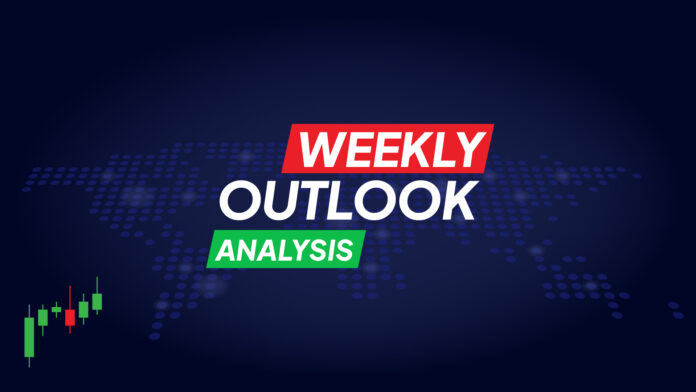Key points to watch out for:
- US GDP, underlying PCE and PMIs to set the tone for dollar trends
- Investors await Bank of Japan’s guidance on the next interest rate hike
- EU and UK PMI indices and Australian CPI to set the agenda this week
- Tech giants’ results brighten earnings season
Will US data push back the possibility of another Fed rate cut?
The US dollar has rallied sharply in the last two weeks, which has motivated bulls to initiate long positions in their trades. Regarding U.S. CPI data, it showed that inflation in the U.S. reaccelerated in March.
Several Federal Reserve (Fed) policymakers, including Chairman Jerome Powell, reported after the release that there is no rush to ease monetary policy sooner rather than later, and last Monday’s retail sales were much stronger than estimated, leading investors to significantly reduce their expectations for rate cuts by 2024. They now expect interest rates to be cut by only 42 basis points, much less than the Fed’s estimate of 75 basis points.
This week’s focus will likely be on the first GDP forecast for the first quarter on Thursday, April 25, as well as the underlying PCE index for March on Friday, April 26. The world’s largest economy posted 3.4% SAAR growth in the last three months of last year and, according to the Atlanta Fed’s GDPNow model, continued to perform very well, with growth of nearly 2.9% in the first quarter. Regarding the core PCE index, which is the Fed’s preferred metric, the firming of consumer prices this month appears to be tilting risks to the upside. On Tuesday, April 23rd, the preliminary S&P global PMIs for April will also be released, and market players may get a sense of how the U.S. economy will fare heading into the second quarter of the year.
This week, filled with solid US data, could further influence the Fed’s rate cut estimates; it remains to be seen whether it will cut rates this year. These developments may give the dollar a chance to stay on track.
Bank of Japan meeting amid possible intervention measures
Another important event this week is the Bank of Japan’s (BoJ) decision on Friday, April 26th. At its most recent meeting, Japan’s monetary policymakers decided to end negative interest rates, raising them by 10 basis points, in addition to ending its yield curve control policy.
That said, with the Bank announcing continued bond purchases at the same levels as before, and Governor Ueda affirming the maintenance of accommodative policy conditions, investors believe any further rate increases will be gradual and slow.
Since that time, even though the market accelerated the timing of a second hike and has an 86% probability for July, the Japanese yen continued to lose value, prompting significant warnings of intervention by the Bank of Japan. Likewise, this did not stop the yen’s slide either.
With the yen falling, Governor Ueda recently stated that the Bank would not directly intervene in currency movements, dispelling speculation that the yen’s depreciation might prompt an earlier rate hike, although a hike is still possible in 2024.
Given the recent pickup in inflation since the last meeting, investors are now watching for signs whether a summer rate hike might be necessary. This means, if there is another bearish appearance, it could trigger a further sell-off in the yen, dramatically increasing the odds of intervention.
Traders can form an opinion on the direction inflation will take in April, a couple of hours before the meeting when the Tokyo CPI is released.
Euro and pound awaiting PMI data
Apart from the US PMI indices, both European and UK PMIs will be released on Tuesday, April 23.
At its most recent meeting, the ECB left interest rates unchanged but signaled potential short-term rate cuts, with reports indicating policymakers expect a quarter-point reduction in June.
As for the Bank of England (BoE), following last week’s better-than-estimated employment data and better-than-estimated inflation figures, it is believed that there will be a 25 basis point rate cut by September.
Recently, both the Eurozone and UK economies have shown signs of improvement, particularly in their latest PMI figures. Although inflation seems to be on track to meet the targets of both central banks, it is unlikely that market estimates for ECB and BoE actions will change significantly. Therefore, it is unlikely that the Euro and the Pound will rebound against the US Dollar.
Is inflation in Australia continuing to slow?
In Australia, although there is a 10% chance that the Reserve Bank of Australia will cut rates at its next policy meeting, it is not entirely clear if there will be a significant rate reduction in 2024. Since the central bank has given no clear signals as to where it may go, market traders will be paying attention to the CPI data scheduled for Wednesday, April 24 to see if inflation continues to slow.
The seasonally adjusted monthly month-over-month rate rose slightly in March, albeit after falling sharply in February versus January, implying that headline inflation may have continued to cool in the first quarter. This situation could raise the probability of a 25 basis point rate cut by the RBA scheduled for December.
Technology sector results will enter the scenario
On Wall Street, the three major indices have recently entered a correction phase due to worsening tensions in the Middle East and the Fed’s increasingly low expectations of a rate cut.
However, apart from these two fundamental issues, equity investors are likely to remain on the lookout for earnings releases, as several high-growth technology giants will be announcing their results this week. On Tuesday, April 23, eyes will be on Alphabet and Tesla, while on Wednesday, April 24, it will be Meta’s turn. On Thursday, April 25, it will be the turn of Microsoft and Amazon.



